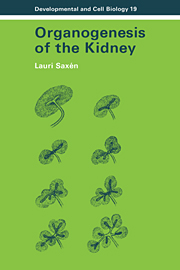Book contents
5 - Vascularization of the nephron
Published online by Cambridge University Press: 22 October 2009
Summary
Introduction
The origin of the endothelial component of the glomerulus and the mode of development of the kidney vasculature have been controversial subjects for a century. The original hypotheses were outlined by embryologists who based their ideas on light-microscopic findings. Later, electronmicroscopic explorations could not settle the varying opinions. The somewhat confusing literature has been reviewed by Jokelainen (1963), Potter (1965), Kazimierczak (1971) and Sariola (1985). Three cell lineages are theoretically potential progenitors for the capillary endothelial cells of the glomeruli, and all these possibilities have found their adherents. Accordingly, the following possible origins can be listed:
Cells of the glomerular anlage, the renal epithelium, derived from the nephrogenic mesenchyme.
Mesenchymal cells, either within the glomerular crevice or invaginating there.
Endothelial cells outside the nephric blastema.
The first hypothesis, the origin in situ of the endothelial cells, was first suggested by Herring (1900). Similar views were presented by Rienhoff (1922) and, especially, by Hall & Roth (1957). The two latter authors observed red blood cells within the glomerular body before capillary lumina were detected. They considered this to be further evidence for the endothelial and hematopoietic potentials of the glomerular cells before the development of outside vessels and connections to them. The finding was confirmed by Kurtz (1958), who also agreed with the conclusions drawn by Hall & Roth of the origin in situ of the hematopoietic and the endothelial cells. This view was shared by Lewis (1958) and Suzuki (1959) and in 1962 by Vernier & Birch-Anderson, who concluded that ‘buds of renal artery join the (glomerular) tuft only after formation of a vascular network in situ within the glomerulus’.
- Type
- Chapter
- Information
- Organogenesis of the Kidney , pp. 129 - 142Publisher: Cambridge University PressPrint publication year: 1987
- 1
- Cited by



